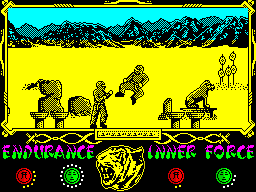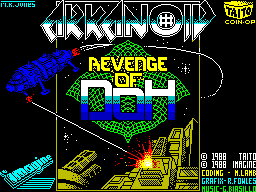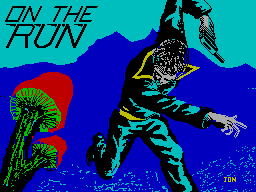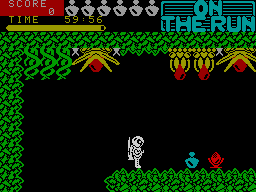Gremlin Graphics entered the ZX Spectrum beat em up arena with Way of the Tiger in May of 1986.
It was the prequel to Avenger (both tied in to those adventure game books - remember those?)
This arcade style game was a little unusal as it had separate 'levels' featuring different styles of fighting such as unarmed combat, pole fighting and swordplay.
The back story tied in the the adenture game books:
You had been abandoned on the shores of the Island of Tranquil Dreams (sounds a nice place for a holiday) and were adopted by an old monk named Naijishi, a Grand Master of the Dawn (whatever that is!)
 |
| Way Of The Tiger Has Loaded |
Before becoming worthy of the noble title of Ninja you had to pass three tests of endurance and skill in combat against opponents chosen by the Master.
The different fighting scenarios were loaded in seperately from cassette - and so Way of the Tiger began.
A nice oriental sounding tune kicked off the action - which took place on a large window on the game screen.
The status area showed how much Endurance and Inner Force you had (represented by circles at the bottom of the display). This was a novel way of displaying your energy levels - for every complete circle of endurance used by a combatant, one point of inner force was deducted. The fighter who's inner force was drained first lost the contest.
The opponents sent to fight you had different levels of endurance and inner force along with a variety of skills. As a fighter's inner force waned, the power of the blows he landed was reduced. Pretty cool really.
The playing area featured a nice triple scrolling effect which allowed three stages of animation on the screen (a decent parallax effect) and gave the player animated backdrops to look at.
As you would expect the fighting took place in the foreground of the screen whilst in the background birds would fly by, logs would float down the river (in the pole fighting level) and so on. These features made for nice environments to brawl in - and this sort of thing was very impressive at the time.
 |
| The Ninja's Fight It Out |
A pointy-eared goblin could jump out from behind a rock to take you on in unarmed combat. Control was setup in the usual (then) beat em up manner using eight directions combined with fire to make a total of sixteen moves.
Each time an opponent was defeated your status levels were topped up in readiness for the next fight. The level continued until all the Master's challengers were overcome - or until you were killed.
Once the desert of Orb had been finished it was on to pole fighting.
This took place on a pole spanning a river - and once again you would be faced by skeletons, dwarves and Ninjas' - all of which were handy with a bo-staff. Once you had overcome this set of bad guys you could make your way to the Grand Temple in the final part of the game...
The scene of the 'final test' was very nicely drawn. Snow-capped mountains reached the sky behind the temple behind you. Birds fluttered by overhead, labourers trundled wheelbarrows across the screen - all in all it was rather serence. Serene until the mad swordsman popped up and started swinging at you.
In samurai sword fighting the Master pitted you against the greatest warriors he knew of. Some of these combatants could perform fighting moves which you could not. The final level was difficult to overcome - it took me twenty or thirty goes before I finally beat them all.
As if that wasn't hard enough you now had to fight the grand master himself! If you managed to overcome him you were finally a fully fledged Ninja - who had sucessfully trodden the Way of the Tiger. Cue dramatic music...
On release:
This game was a big hit back in 1986. Gamers likes the large and well animated fighters, the variety of fighting styles (and moves) and the superbly drawn backgrounds. The 3 layered scrolling was a joy to behold - and Way of the Tiger was a superb addition to the beat em up genre. One niggle was loading in the different sections, but the fact that you could practice each section before playing proper was a bonus too.
The test of time:
Well I used to love this arcade game (especially the unarmed combat section) - but I just can't get into it these days. I dunno - the opponents don't show much AI - it all seems a bit random. The graphics are nice to look at - and the background/foreground movement is pretty cool. I must say I still prefer Way of the Exploding Fist.
Maybe stick on a bit of Eye of the Tiger and give it a go.
We recommend getting hold of the real Sinclair ZX Spectrum hardware, but if not then download a ZX Spectrum emulator and download Way of the Tiger. Alternatively you could try and play it online.
Please see our other ZX Spectrum retro game reviews - all links are listed in alphabetical order. Cheers guys.
GENRE: Arcade beat em up game
RELEASE DATE: May 1986
RELEASED BY: Gremlin Graphics
DEVELOPER(S): Shaun Hollingworth, Chris Kerry, Pete Harrap, Marco Duroe
PRICE: £9.95
Unarmed Combat - classic arcade game action:
Swing your sword wisely... more arcade gaming:
Classic Games, Arcade Games and ZX Spectrum Games









 ZX Spectrum Armageddon
ZX Spectrum Armageddon As you progressed through the levels the difficulty increased with thicker waves of missiles to destroy which dropped from the sky more quickly.
As you progressed through the levels the difficulty increased with thicker waves of missiles to destroy which dropped from the sky more quickly.

